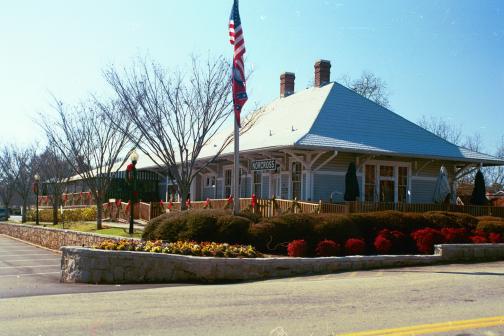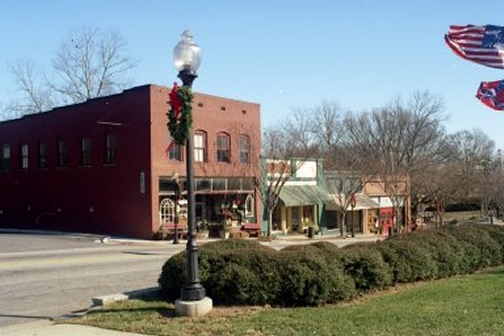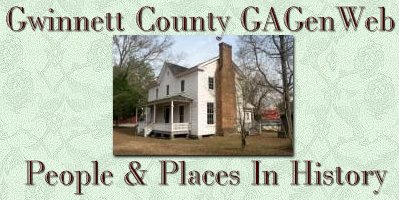For many years
Norcross was a resort town and center of
commerce. Tourists and businessmen
traveled to Norcross by train to stay in the new
29 room Brunswick Hotel at the corner of Jones
and Thrasher Streets, and farmers came into town
to purchase supplies and process and sell their
cotton and other products. Families
from across the Chattahoochee River would cross
by ferry to come to Norcross. The main
river crossings were Nesbit Ferry, Jones Ferry
and Medlock Ferry, named after the
families who owned the land.
The Airline Belle,
a four coach commuter train, began making two
round trips from Norcross to Atlanta every
day, beginning in 1878. Merchants
would bring their wares to the resort hotel
for tourists to peruse.
Public education was not
available in Georgia until after the War, and
Norcross offered its first free public school
in 1871. Children would travel from as
far away as the Pinckneyville community to go
to school, often walking and
carrying their lunches in buckets.
Soon afterward (1872 or 1877) a Mr. Norman
Favius Cooledge moved to Norcross and
established a boarding school right next door,
and children from miles around boarded here.
In 1903 a new
two-story red brick school building was
erected on College Street, overlooking the
town. It had a bell tower, and
upstairs featured an auditorium.
Downstairs were four classrooms, heated by
wood stoves.
Norcross Methodist
Church was originally organized as Flint Hill
Methodist Church in the 1820s and was located
about a mile from Norcross. When
the Southern Railway was completed in 1871 the
Flint Hill church was relocated to Norcross
and renamed the Norcross Methodist
Church. The original windows were later
replaced with arched stained glass windows,
and a log cabin was erected in the back for
the children.
Mt. Carmel Methodist Church was located two
and one half miles north of Norcross on
Peachtree Road. It was organized in
1828. Among the founding members were
Robert McAfee, Jack Gregory, Wiley Jones,
Billie Ginkins. Daniel N. Pittman
donated five acres for the church. The
first building was erected around the time the
church was organized. The second
building was built in 1876 under the pastorate
of Rev. M.M. Newton. The present
building (1959) was built in 1925 under the
pastorate of Rev. Duncan.
Bethel
Baptist
Church
was
organized August 11, 1869, two miles west of
present day Norcross. The four charter
members were Mr. and Mrs. J.T.O. Beard, Mr.
and Mrs. J.F. Holbrook and M. L. Walker.
Norcross
Baptist
Church
was
organized in 1872, shortly after the
completion of the railroad. Among the
charter members were Mr. and Mrs. J. P.
Simmons and their daughters, Mr. and Mrs.
David Thrasher, Major and Mrs. James, Mr. and
Mrs. G. Rakestraw, Mr. and Mrs. J. A. Jackson,
Miss Jackson, Mr. and Mrs. J. J. Thrasher, and
Mr. and Mrs. William Davis.
Hopewell Christian Church was organized
in September, 1886 with twelve charter
members. In 1911 Bliss Woodward was
superintendent of the Sunday school.
D.Jr. Funderburg was assistant superintendent;
Miss Velva White, secretary; Paul Jackson,
chorister; Miss May Funderburg,
organist; Miss Mamie Jones, Paul Jackson
and D.J. Funderburg, teachers.
Among the
early businesses in Norcross were Mr.
E.T. McElroy's saw mill and furniture
factory, Medlock Harness Factory,
Norcross Manufacturing Company (also
harnesses), and Johnson's Store, originally a
general dry goods store, and later a hardware
store, and the Summerhour Cotton Gin, where a
new improved high-fiber cotton, called Half
and Half, was developed.
Edward F.
Buchanan was born in 1871 and adopted by the
Norcross family of Leslie and Martha
Buchanan.  Edward
spent much of his time as a boy at the
Norcross Depot and quickly learned the
telegraph code. When only 13, he
traveled west, working as a telegraph
operator. In the 1890's he returned to
Atlanta and married Bertie Redwine.
Shortly after the marriage they moved to New
York, where Edward became a successful stock
broker.
Edward
spent much of his time as a boy at the
Norcross Depot and quickly learned the
telegraph code. When only 13, he
traveled west, working as a telegraph
operator. In the 1890's he returned to
Atlanta and married Bertie Redwine.
Shortly after the marriage they moved to New
York, where Edward became a successful stock
broker.
Edward never
forgot his hometown of Norcross. He
erected a stone mansion for his mother
directly across from Thrasher Park, and it had
every modern convenience, including water and
electricity. He often visited
Norcross, riding in his private Pullman car
from New York, and established the Buchanan
Plow and Implement Company and the United
Electric Manufacturing Company.
From 1907 to
1908 Edward Buchanan moved to Norcross
and began the first automobile manufacturing
company in Georgia. His automobile,
called the Norcross, was sold to some
of his wealthy New York friends, but the
company did not survive. Mr. Buchanan's
logo was Nor-X, the X meaning to represent a
cross or cross roads. It is said that
the general public was somewhat confused about
the meaning of the logo, and the car was
called everything from "Nor-x" to "Nort."
George Reed
contributed this information about Norcross
and the name "Peachtree":
My name
is George T Reed Mr. Noye H Nesbit,
(NHN) Norcross native, deceased. He was
born in Norcross on Thrasher Street, educated
Georgia Tech 1917, etc. He told many
stories which I have recorded and typed. One
that I must bring to your attention is his
recollections of Peachtree Road.
When NHN was a small
boy, ca 1903-5, he was in a horse-drawn wagon
riding with his grandmother. As they approached
the shallow place in the Chattahoochie to cross
over, his grandmother told him (essentially):
Over there is where
William Nesbit and two other men, (and their
"helpers"...slaves), finished marking out a road
from Hog Mountain to Alabama. When they got to
the Chattahoochie (shallow place), they all were
sititng around and one of the crew asked, "What
shall we call this road?" Another said
(words essentially), "...see that pine tree and
the pitch (resin) (where the Indians had gotten
pitch to seal their canoes) ? Another
said, lets call it Pitch Tree Road. Thus this
was the first name of the famous name now in
Atlanta, etc.
William Nesbit
was later on a three-man commission to name
the present road, Peachtree Road. I do
NOT know which of the three men suggested
"Pitch Tree road". I want to think it
was William Nesbit, but I do NOT know which of
the three men suggested "Pitch Tree. etc.
You'll find more
photographs and vintage postcards of Norcross in
our Gwinnett County PHOTO
ALBUM!


 Edward
spent much of his time as a boy at the
Norcross Depot and quickly learned the
telegraph code. When only 13, he
traveled west, working as a telegraph
operator. In the 1890's he returned to
Atlanta and married Bertie Redwine.
Shortly after the marriage they moved to New
York, where Edward became a successful stock
broker.
Edward
spent much of his time as a boy at the
Norcross Depot and quickly learned the
telegraph code. When only 13, he
traveled west, working as a telegraph
operator. In the 1890's he returned to
Atlanta and married Bertie Redwine.
Shortly after the marriage they moved to New
York, where Edward became a successful stock
broker. 

